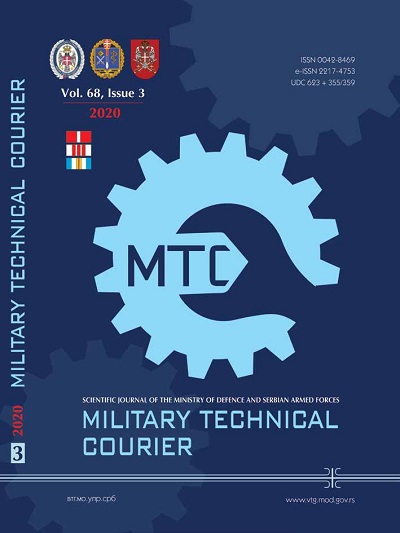Electrically conductive fibers in cluster bomblets which targeted the electric power system of FR Yugoslavia in 1999
Abstract
Introduction/purpose: The paper presents the mode of operation of the CBU-102(V) 2/B cluster bomb, weighing about 340 kg and containing bomblets with electrically conductive fibers for disabling power plants.
Methods: Physical and chemical analyses of the fibers were performed. The following test methods were used for fiber characterization: a binocular microscope for determining fiber thickness and a qualitative XRF analysis performed on an XRF-MiniPal spectrometer, PANalytical. The XRFanalysis aimed at qualitative detection of the present elements, which was confirmed by a quantitative chemical analysis.
Results: The semi-quantitative XRF analysis determined the content of gallium (0.007%), the peak of which was detected on the spectrum. Gallium nitride is a material that can be used as a semiconductor. The chemical analysis was performed on an atomic absorption spectrophotometer Analyst 300, Perkin Elmer.
Conclusion: The instrument for differential thermal analysis and thermogravimetry (DTA/TG), NETZCH STA 409 EP (operational range from 20°C to 1000°C), confirmed that the sample was of 50% silicate origin, non-toxic and with heavy metal content in traces. The rest of the sample is aluminum whose presence in soil can cause decline in soil fertility thus leading to decline in crop yields.
References
Anđelković-Lukić, M. 2015. Darovi milosrdnog anđela - Ekološko razmatranje rata NATO protiv SR Jugoslavije, 2. dopunjeno izdanje. Novi Sad: Balkanija (in Serbian).
-Dveri srpske. 2009. Nato genocid. Dveri srpske, 10(41), pp.68-69 (in Serbian).
-Energy Agency of the Republic of Serbia. 2017. Document number: 312-3/2016-C-1, January 26, p.8. Belgrade: Energy Agency of the Republic of Serbia (in Serbian).
Fang, W., Shunshan, F., Wenxuan, W. & Fuwang, L. 2010. Analysis of action mechanism of graphite bombs and reaction method of power system. In: International Conference on Power System Technology (POWERCON 2010), Zhejiang, China, pp.1-6, October 24-28. Available at: https://doi.org/10.1109/POWERCON.2010.5666135
Jeler, G.E. & Roman, D. 2016. The Graphite Bomb: An Overview of its Basic Military Applications. Review of the Air Force Academy, 14(1), pp.13-18. Available at: https://doi.org/10.19062/1842-9238.2016.14.1.2.
Mrvić, V., Čakmak, D., Sikirić, B., Nikoloski, M., Delić, D., Belanović, S. & Beloica, J. 2012. Effect of acidification on the content of water-soluble aluminium in pseudogleys. Ratarstvo i povrtarstvo, 49(3), pp.257-262 (in Serbian). Available at: https://doi.org/10.5937/ratpov49-2293.
Rondeau, V., Commenges, D., Jacqmin-Gadda, H. & Dartigues, J-F. 2000. Relation between Aluminum Concentrations in Drinking Water and Alzheimer's Disease: An 8-year Follow-up Study. American Journal of Epidemiology, 152(1), pp.59-66. Available at: https://doi.org/10.1093/aje/152.1.59.
-Serbian Armed Forces (SAF). 1999. General Staff Archive. Belgrade: Serbian Armed Forces (SAF).
Proposed Creative Commons Copyright Notices
Proposed Policy for Military Technical Courier (Journals That Offer Open Access)
Authors who publish with this journal agree to the following terms:
Authors retain copyright and grant the journal right of first publication with the work simultaneously licensed under a Creative Commons Attribution License that allows others to share the work with an acknowledgement of the work's authorship and initial publication in this journal.
- Authors are able to enter into separate, additional contractual arrangements for the non-exclusive distribution of the journal's published version of the work (e.g., post it to an institutional repository or publish it in a book), with an acknowledgement of its initial publication in this journal.
- Authors are permitted and encouraged to post their work online (e.g., in institutional repositories or on their website) prior to and during the submission process, as it can lead to productive exchanges, as well as earlier and greater citation of published work (See The Effect of Open Access).

